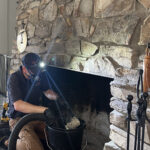How to Close Off a Fireplace for Spring & Summer
It’s that time again when hot weather puts an end to the joys of an indoor fire. Online searches on how to close off a fireplace for spring and summer are aplenty. Many don’t even realize that closing a fireplace and chimney in summer is actually a safety issue. To follow expert advice, you are going to need the help of a certified chimney sweep. For that, you can call the certified chimney professionals at Chimney Solutions, serving the Atlanta and Chattanooga areas. Info on how to close off your fireplace follows.
 Wood-Burning Fireplace: Close the Damper
Wood-Burning Fireplace: Close the Damper
Energy costs are the issue when it comes to closing your damper. It’s best not to assume that your damper seals when it closes, however. If a gap exists so that air can pass through damper doors, you are going to have higher than necessary electricity bills. You can contact a chimney sweep for damper repair and damper replacement. Another option–and the most energy efficient–is to get a top-sealing damper.
Gas Logs: Pilot Light on, Open the Damper
If you keep the pilot light on during the off-season, the damper should stay open, even in summer. The pilot light produces carbon monoxide, a toxic combustion gas that is potentially deadly. Should you turn off the pilot light, it is safe to close the damper. Closing it is better because your A/C costs won’t be as high.
Schedule Chimney Cleaning
The first thing to do when you close off a fireplace for spring and summer is schedule chimney cleaning with a professional. Wood-burning fireplaces produce creosote, which is a toxic, tar-like substance. Creosote is acidic and it builds up in the flue in layers. It should be removed at least annually.
Bad odors could seep into your home if the creosote isn’t removed. More importantly, the acidic nature of creosote could corrode your chimney flue. If a chimney liner has the slightest amount of damage, it can endanger your family. If the flue isn’t intact, the hazards you may be exposed to are deadly carbon monoxide and a house fire that results from a process called pyrolysis.
Clean your Fireplace
Cleaning your fireplace is part of closing off your fireplace for spring and summer. Before giving the fireplace a scrubbing, remove the ash, the iron grates, and the remaining firewood. Using an iron paste and a stiff dry brush, clean your iron grate. To clean fireplace doors, follow the manufacturer’s instructions.
The following are two ways to mix a cleaning solution for removing soot stains from your fireplace and hearth—though there are more:
1. Apply a mild dishwashing soap to remove the bulk of the soot. Dilute ¼ cup grease-cutting dish soap in four cups of water.
2. The acidic nature of distilled white vinegar could damage bricks 20 years old or older. Otherwise, vinegar is a good cleaning option. To make the cleaning solution, mix vinegar with warm water in equal parts. Add about 2 tablespoons of dishwashing detergent to every gallon of the vinegar mixture.
 Chimney Solutions Cleans Chimneys & More
Chimney Solutions Cleans Chimneys & More
Contact Chimney Solutions for chimney cleaning. That’s really the first step of closing off a fireplace for spring and summer. Cleaning may not be as easy as using a professional chimney sweeping brush. There are three kinds of creosote and two of them require special equipment and a professional touch to accomplish. Our CSIA-certified chimney sweeps offer every kind of chimney maintenance, such as flashing repair, chimney inspections, masonry repair, chimney crown rebuilds, and more.
Schedule an appointment today using our contact form or give us a call. In the Atlanta area, call 770-255-1300 today. For chimney sweep professionals in Chattanooga, TN, call 423-551-9912.




